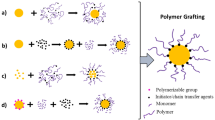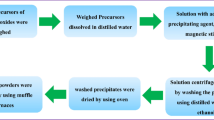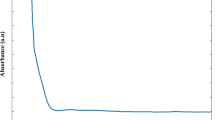Abstract
As an inorganic filler, the fine particle talcum powder exhibits the poor compatibility when blended with polymers. By the “grafting from” method, a modified talcum powder (Talc-g-pla) was synthesized by the ring-opening polymerization (ROP) of lactide in bulk. The polymer chains grew in situ and chemically grafted on the talc surface, which was tightly connected even after washing with dichloromethane for 24 h. The Fourier transform infrared spectroscopy (FTIR), atomic force microscope (AFM), and the thermogravimetric analysis (TGA) of Talc-g-pla confirmed the successful modification of talc with PLA, which was about 2 wt%. Due to the good compatibility by the grafted PLA as a bridge between PLA and talc, the Talc-g-pla was well dispersed and served as an efficient nucleating agent of commercial PLA at low loadings. For the PLA/Talc-g-pla composite by the blend of Talc-g-pla with PLA in the proportions between 0.5–3.0 wt%, the differential scanning calorimeter (DSC) and polarized optical microscope (POM) showed that the improvement of thermodynamic properties and crystallization of PLA/Talc-g-pla composites were more obvious than those of the PLA/Talc physical composites. The DSC results suggested that the 1 wt% Talc-g-pla increased the crystallinity of PLA by over 3% than talc.










Similar content being viewed by others
Data availability
The authors declare that the data supporting the findings of this study are available within the paper and its Supplementary Information files.
References
Rezvani Ghomi E, Khosravi F, Saedi Ardahaei A, Dai Y, Neisiany RE, Foroughi F, Wu M, Das O, Ramakrishna S (2021) The life cycle assessment for polylactic acid (PLA) to make it a low-carbon material. Polymers (Basel) 13(11):1854
Araujo A, Botelho G, Oliveira M, Machado AV (2014) Influence of clay organic modifier on the thermal-stability of PLA based nanocomposites. Appl Clay Sci 88–89:144–150
Armentano I, Bitinis N, Fortunati E, Mattioli S, Rescignano N, Verdejo R, Lopez-Manchado MA, Kenny JM (2013) Multifunctional nanostructured PLA materials for packaging and tissue engineering. Prog Polym Sci 38(10–11):1720–1747
Nofar M, Sacligil D, Carreau PJ, Kamal MR, Heuzey MC (2019) Poly (lactic acid) blends: Processing, properties and applications. Int J Biol Macromol 125:307–360
Cheng C, Liao Z, Huang J, Huang S, Fan W (2017) Incorporation of supramolecular polymer-functionalized graphene: Towards the development of bio-based high electrically conductive polymeric nanocomposites. Compos Sci Technol 148:89–96
Tyler B, Gullotti D, Mangraviti A, Utsuki T, Brem H (2016) Polylactic acid (PLA) controlled delivery carriers for biomedical applications. Adv Drug Deliv Rev 107:163–175
Saini P, Arora M, Kumar M (2016) Poly(lactic acid) blends in biomedical applications. Adv Drug Deliv Rev 107:47–59
Chu W, Cheng C, Bastakoti BP, Kuo S (2016) Hierarchical mesoporous silicas templated by PE-b-PEO-b-PLA triblock copolymer for fluorescent drug delivery. RSC Adv 6(40):33811–33820
Basu A, Nazarkovsky M, Ghadi R, Khan W, Domb AJ (2017) Poly(lactic acid)-based nanocomposites. Polym Adv Technol 28(8):919–930
Lai WC, Liu LJ (2022) Enhanced crystallization of poly(lactic acid) bioplastics by a green and facile approach using liquid poly(ethylene glycol). Polym Adv Technol 33(12):4131–4141
Hamad K, Kaseem M, Ayyoob M, Joo J, Deri F (2018) Polylactic acid blends: The future of green, light and tough. Prog Polym Sci 85:83–127
Zhang C, Zhai T, Turng L-S, Dan Y (2015) Morphological, mechanical, and crystallization behavior of polylactide/polycaprolactone blends compatibilized by l-lactide/caprolactone copolymer. Ind Eng Chem Res 54(38):9505–9511
Zhao H, Cui Z, Sun X, Turng L-S, Peng X (2013) Morphology and properties of injection molded solid and microcellular polylactic acid/polyhydroxybutyrate-valerate (PLA/PHBV) blends. Ind Eng Chem Res 52(7):2569–2581
Liu X, Wang T, Chow L C, Yang M, Mitchell J W (2014) Effects of inorganic fillers on the thermal and mechanical properties of poly(lactic acid). Int J Polym Sci
Huda MS, Drzal LT, Misra M, Mohanty AK, Williams K, Mielewski DF (2005) A study on biocomposites from recycled newspaper fiber and poly(lactic acid). Ind Eng Chem Res 44(15):5593–5601
Kaynak C, Erdogan AR (2016) Mechanical and thermal properties of polylactide/talc microcomposites: Before and after accelerated weathering. Polym Adv Technol 27(6):812–822
Harris AM, Lee EC (2008) Improving mechanical performance of injection molded PLA by controlling crystallinity. J Appl Polym Sci 107(4):2246–2255
Choi WJ, Kim SC (2004) Effects of talc orientation and non-isothermal crystallization rate on crystal orientation of polypropylene in injection-molded polypropylene/ethylene-propylene rubber/talc blends. Polymer 45(7):2393–2401
Ouchiar S, Stoclet G, Cabaret C, Georges E, Smith A, Martias C, Addad A, Gloaguen V (2015) Comparison of the influence of talc and kaolinite as inorganic fillers on morphology, structure and thermomechanical properties of polylactide based composites. Appl Clay Sci 116:231–240
Li HB, Huneault MA (2007) Effect of nucleation and plasticization on the crystallization of poly(lactic acid). Polymer 48(23):6855–6866
Tabi T, Suplicz A, Czigany T, Kovacs JG (2014) Thermal and mechanical analysis of injection moulded poly(lactic acid) filled with poly(ethylene glycol) and talc. J Therm Anal Calorim 118(3):1419–1430
Petchwattana N, Covavisaruch S, Petthai S (2014) Influence of talc particle size and content on crystallization behavior, mechanical properties and morphology of poly(lactic acid). Polym Bull (Berlin) 71(8):1947–1959
Xin S, Li Y, Zhao H, Bian Y, Li W, Han C, Dong Q, Ning Z, Dong L (2015) Confinement crystallization of poly(L-lactide) induced by multiwalled carbon nanotubes and graphene nanosheets. J Therm Anal Calorim 122(1):379–391
Xu P, Tian H, Han L, Yang H, Bian J, Pan H, Zhang H (2021) Improved heat resistance in poly (lactic acid)/ethylene butyl methacrylate glycidyl methacrylate terpolymer blends by controlling highly filled talc particles. J Therm Anal Calorim
De Santis F, Pantani R (2015) Melt compounding of poly (lactic acid) and talc: Assessment of material behavior during processing and resulting crystallization. J Polym Res 22(12)
Ke T, Sun X (2003) Melting behavior and crystallization kinetics of starch and poly(lactic acid) composites. J Appl Polym Sci 89(5):1203–1210
Hong Y, Chen L, Song G, Bassir D, Cheng S, Shi X, Liu H, Tang G (2018) Effect of in situ reaction on thermal and mechanical properties of polylactide/talc composites. Polym Compos 39:E1618–E1625
Jo MY, Ryu YJ, Ko JH, Yoon JS (2013) Hydrolysis and thermal degradation of poly(L-lactide) in the presence of talc and modified talc. J Appl Polym Sci 129(3):1019–1025
Deetuam C, Samthong C, Choksriwichit S, Somwangthanaroj A (2020) Isothermal cold crystallization kinetics and properties of thermoformed poly(lactic acid) composites: Effects of talc, calcium carbonate, cassava starch and silane coupling agents. Iran Polym J 29(2):103–116
Barletta M, Pizzi E, Puopolo M, Vesco S (2017) Design and manufacture of degradable polymers: Biocomposites of micro-lamellar talc and poly(lactic acid). Mater Chem Phys 196:62–74
Carlmark A, Larsson E, Malmstrom E (2012) Grafting of cellulose by ring-opening polymerisation - a review. Eur Polym J 48(10):1646–1659
Macchione MA, Biglione C, Strumia M (2018) Design, synthesis and architectures of hybrid nanomaterials for therapy and diagnosis applications. Polymers (Basel) 10(5):527
Wu L, Glebe U, Boker A (2015) Surface-initiated controlled radical polymerizations from silica nanoparticles, gold nanocrystals, and bionanoparticles. Polym Chem 6(29):5143–5184
Nordgren N, Lonnberg H, Hult A, Malmstrom E, Rutland MW (2009) Adhesion dynamics for cellulose nanocomposites. ACS Appl Mater Interfaces 1(10):2098–2103
Luan Y, Wu J, Zhan M, Zhang J, Zhang J, He J (2013) “One pot” homogeneous synthesis of thermoplastic cellulose acetate-graft-poly(L-lactide) copolymers from unmodified cellulose. Cellulose 20(1):327–337
Jiang Y, Zhang Y, Cao M, Li J, Wu M, Zhang H, Zheng S, Liu H, Yang M (2021) Combining 'grafting to' and 'grafting from' to synthesize comb-like NCC-g-PLA as a macromolecular modifying agent of PLA. Nanotechnology 32(38):385601
Michot LJ, Villieras F, Francois M, Yvon J, Le Dred R, Cases JM (1994) The structural microscopic hydrophilicity of talc. Langmuir 10(10):3765–3773
Li H, Wang J, Wu L, Liu W, Cheng R, Liu B (2019) Ring-opening polymerization of lactide by bifunctional organocatalyst at ambient conditions. Acta Polym Sin 50(12):1290–1297
Wu L, Liu W, Ye J, Cheng R (2020) Fast cyclotrimerization of a wide range of isocyanates to isocyanurates over acid/base conjugates under bulk conditions. Catal Commun 145:106097
Feng Z, Wu L, Dong H, Liu B, Cheng R (2021) Copolyesters of epsilon-caprolactone and l-lactide catalyzed by a tetrabutylammonium phthalimide-N-oxyl organocatalyst. RSC Adv 11(31):19021–19028
Du C, Yuan H, Zhu X, Zhang T, Liu Z, Wang C (2023) Fabrication of antibacterial zr-bmg biomimetic surfaces by femtosecond laser. Surf Interfaces 37:102740
Murariu M, Doumbia A, Bonnaud L, Dechief AL, Paint Y, Ferreira M, Campagne C, Devaux E, Dubois P (2011) High-performance polylactide/ZnO nanocomposites designed for films and fibers with special end-use properties. Biomacromol 12(5):1762–1771
Su Z, Li Q, Liu Y, Hu G, Wu C (2009) Compatibility and phase structure of binary blends of poly(lactic acid) and glycidyl methacrylate grafted poly(ethylene octane). Eur Polym J 45(8):2428–2433
Battegazzore D, Bocchini S, Frache A (2011) Crystallization kinetics of poly(lactic acid)-talc composites. Express Polym Lett 5(10):849–858
Rotenberg B, Patel AJ, Chandler D (2011) Molecular explanation for why talc surfaces can be both hydrophilic and hydrophobic. J Am Chem Soc 133(50):20521–20527
Cuba-Chiem LT, Huynh L, Ralston J, Beattie DA (2008) In situ particle film atr ftir spectroscopy of carboxymethyl cellulose adsorption on talc: Binding mechanism, ph effects, and adsorption kinetics. Langmuir 24(15):8036–8044
Bahrani A, Naderi R, Mahdavian M (2018) Chemical modification of talc with corrosion inhibitors to enhance the corrosion protective properties of epoxy-ester coating. Prog Org Coat 120:110–122
Monika KV (2019) Non-isothermal degradation kinetics of PLA-functionalized gum (fg) biocomposite with dicumyl peroxide (dcp). J Therm Anal Calorim 138(1):195–210
Li C, Gong W, Cao Q, Yao Z, Meng X, Xin Z (2022) Enhancement of cardanol-loaded halloysite for the thermo-oxidative stability and crystallization property of polylactic acid. Appl Clay Sci 216:106357
Fowlks AC, Narayan R (2010) The effect of maleated polylactic acid (PLA) as an interfacial modifier in PLA-talc composites. J Appl Polym Sci 118(5):2810–2820
Pivsa-Art W, Pivsa-Art S (2019) Effect of talc on mechanical characteristics and fracture toughness of poly(lactic acid)/poly(butylene succinate) blend. J Polym Environ 27(8):1821–1827
Nascimento L, Gamez-Perez J, Santana OO, Velasco JI, Maspoch ML, Franco-Urquiza E (2010) Effect of the recycling and annealing on the mechanical and fracture properties of poly(lactic acid). J Polym Environ 18(4):654–660
Jain S, Misra M, Mohanty AK, Ghosh AK (2012) Thermal, mechanical and rheological behavior of poly(lactic acid)/talc composites. J Polym Environ 20(4):1027–1037
Ouchiar S, Stoclet G, Cabaret C, Gloaguen V (2016) Influence of the filler nature on the crystalline structure of polylactide-based nanocomposites: New insights into the nucleating effect. Macromolecules 49(7):2782–2790
Pan P, Kai W, Zhu B, Dong T, Inoue Y (2007) Polymorphous crystallization and multiple melting behavior of poly(L-lactide): Molecular weight dependence. Macromolecules 40(19):6898–6905
Nofar M, Zhu W, Park CB, Randall J (2011) Crystallization kinetics of linear and long-chain-branched polylactide. Ind Eng Chem Res 50(24):13789–13798
Liao R, Yang B, Yu W, Zhou C (2007) Isothermal cold crystallization kinetics of polylactide/nucleating agents. J Appl Polym Sci 104(1):310–317
Cho JD, Baratian S, Kim J, Yeh FJ, Hsiao BS, Runt J (2003) Crystallization and structure formation of poly(L-lactide-co-meso-lactide) random copolymers: A time-resolved wide- and small-angle x-ray scattering study. Polymer 44(3):711–717
Author information
Authors and Affiliations
Corresponding authors
Additional information
Publisher's Note
Springer Nature remains neutral with regard to jurisdictional claims in published maps and institutional affiliations.
Supplementary Information
Below is the link to the electronic supplementary material.
Rights and permissions
Springer Nature or its licensor (e.g. a society or other partner) holds exclusive rights to this article under a publishing agreement with the author(s) or other rightsholder(s); author self-archiving of the accepted manuscript version of this article is solely governed by the terms of such publishing agreement and applicable law.
About this article
Cite this article
Zhu, S., Sun, M., Meng, X. et al. Crystallization improvement of PLA by the talc with “grafting from” method of polymerization of lactide. J Polym Res 31, 20 (2024). https://doi.org/10.1007/s10965-023-03857-6
Received:
Accepted:
Published:
DOI: https://doi.org/10.1007/s10965-023-03857-6




